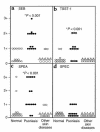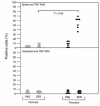Epidermal HLA-DR and the enhancement of cutaneous reactivity to superantigenic toxins in psoriasis
- PMID: 10545517
- PMCID: PMC409817
- DOI: 10.1172/JCI6835
Epidermal HLA-DR and the enhancement of cutaneous reactivity to superantigenic toxins in psoriasis
Abstract
Streptococcal and staphylococcal superantigens (SAg's) have been implicated in the pathogenesis of inflammatory skin diseases, but the mechanisms by which these toxins act are unknown. The present study assessed the ability of nanogram quantities of topically applied purified toxic shock syndrome toxin-1 (TSST-1), staphylococcal enterotoxin type B, and streptococcal pyrogenic enterotoxin types A and C to induce inflammatory reactions in clinically uninvolved skin of normal controls and subjects with psoriasis, atopic dermatitis, and lichen planus. These SAg's triggered a significantly greater inflammatory skin response in psoriatics than in normal control subjects or in subjects with atopic dermatitis or lichen planus. Surprisingly, skin biopsies did not exhibit the T-cell receptor Vbeta stimulatory properties predicted for SAg-induced skin reactions. By 6 hours after patch testing with SAg's, TNF-alpha mRNA had increased in the epidermis (but not the dermis) in biopsies from psoriatics, compared with controls. Immunohistochemical studies revealed significantly higher HLA-DR expression in keratinocytes from psoriatics than from controls. However, a mutant TSST-1 protein that fails to bind HLA-DR did not elicit an inflammatory skin reaction. These results indicate that keratinocyte expression of HLA-DR enhances inflammatory skin responses to SAg's. They may also account for previous studies failing to demonstrate selective expansion of T-cell receptor Vbetas in psoriatics colonized with SAg-producing Staphylococcus aureus, and they identify a novel T cell-independent mechanism by which SAg's contribute to the pathogenesis of inflammatory skin diseases.
Figures







Comment in
-
Skin innate immune system in psoriasis: friend or foe?J Clin Invest. 1999 Nov;104(9):1161-4. doi: 10.1172/JCI8633. J Clin Invest. 1999. PMID: 10545511 Free PMC article. Review. No abstract available.
References
-
- Nickoloff BJ. The cytokine network in psoriasis. Arch Dermatol. 1991;127:871–884. - PubMed
-
- Henderson CA, Highet AS. Acute psoriasis associated with Lancefield Group C and Group G cutaneous streptococcal infections. Br J Dermatol. 1988;118:559–561. - PubMed
-
- Leung DYM, Walsh P, Giorno R, Norris DA. A potential role for superantigens in the pathogenesis of psoriasis. J Invest Dermatol. 1993;100:225–228. - PubMed
Publication types
MeSH terms
Substances
Grants and funding
LinkOut - more resources
Full Text Sources
Medical
Research Materials

